Why do people write photography books ? For the money , not because they want to help people !
{Please note : I am not condemning entire books - just warning about information that could be misleading to a beginner - the rest of the information in the books mentioned is useful ! }
Many of these people are very knowledgeable about photography but are not necessarily 100% right in all their statements .
As I read through some of the more popular books I see mistakes that could greatly mislead beginners so I thought I would list them here for the benefit of beginners trying to find their way through a sea of [ sometimes incorrect] information .
It's confusing enough as a beginner without reading misleading statements that could further confuse your learning process !
I am busy with this book and on page 18 the author makes the statement about "BL" flash that in this mode " the flash is trying to make the foreground and background roughly equivalent exposure zones " .... that's close to what the manual says which is also ambiguous . Then he goes on to state that if the background is dark it will blow the subject trying to light the background as well . Nothing could be further from the truth ! In my blog on TTL/BL I explain my tests and how it really works .
{5/03/2010 :
I've decided to expand on this particular subject since many are questioning my basis for stating that the book's description is totally wrong . The problem lies primarily with Nikon who haven't explained things properly to us .
Page 37 of the SB800 manual describes TTL/BL flash in a very ambiguous way [ I'll go so far as to say the manual is wrong as well in this respect ] ... with regard to TTL/BL "Automatic balanced Fill Flash " it states " The flash output is adjusted for a well balanced exposure of the main subject and background " .... work that one out without getting everyone confused . I started doing tests with TTL/BL flash almost a year ago on Nikoncafe . After many test images [ you can see them on my photobucket album in the "flash" album , most have text on them ] I concluded that TTL/BL only cares about correct exposure on the subject and is far more accurate than TTL flash .
To stick to the subject at hand with TTL/BL it would be more accurate to read : " The flash output level is automatically adjusted for a well balanced exposure of the main subject taking the 'background' or ambient lighting already on it into account " .
As they say "a picture speaks a thousand words "
The author stated that the flash would "arm the photon warhead " and " obliterate the darkness " .. some simple tests will confirm the inaccuracy of this statement .
To digress slightly TTL flash does this when the subject is smaller than the metering area in the centre of the frame ...
Now we go to TTL/BL , due to the fact that it can 'map out' its subject using the matrix metering pattern - and has the advantage of distance info - it is much more accurate :
So : Did TTL/BL try to obliterate the darkness ? No , it concentrated on the subject . If anyone still doesn't believe me than all you have to do is try it out for yourself and you will see that the statement that TTL/BL will try to light the background is totally wrong .
So , Never base your statements on something you have read in a manual or heard from someone else - do your own tests and you will learn so much more .... and never make statements in a book based on what you think the manual means - it will get back to you in the end ! }
The incorrect statement is due to a rather ambiguous statement in the Nikon manual that has been badly misinterpreted . In reality , the wireless CLS that the author praises so highly uses the same metering mode as TTL/BL ! BL mode will try to get perfect exposure on the subject " and take the ambient[ background] lighting on the subject into account " - that's the balancing part of it .
On to page 258 " I want the light source to be at least twice as far away as I had it , so that's gonna mean twice the power " ..... this is totally wrong , due to the inverse square law twice the distance means 4X the power !
This may have been a genuine mistake overlooked by a hasty review before publishing - but it's going to have a lot of beginners believing the wrong thing . I can understand a hastily written website that can be changed but there is little excuse for not checking the info that will be released in a book with no chance to change it later .
Update : 8/04/2010 . I've finished reading the other book from this author and was rather disturbed at his statements about telling people anything they want to hear to get the job and achieve success .
I don't agree with lying to get what you want and at that ''moment it clicked'' ...... how much of a book ' written to make money' can you believe from an author who advocates lying to achieve success ???
The other book I was reading recently ....
.... has a suggestion on page 41 about using fill flash outdoors .
I have seriously never seen anything so pointless !
How much of the light in this image do you think is going to go forward .... maybe 1% of 5% ? You'll have your flash firing at full power every shot just to put catch-lights in the subjects eyes , and those catch-lights will be "L"- shaped .
No wonder we have global warming and professionals complain about burning out flash heads !
Please note : I agree that fill flash should be used outdoors ! You will do well to follow the advice to use it .... BUT : wasting flash into the air makes no sense when you can simply dial back direct flash for the same results and use less than 1/100th of the power .
This weekend I will do some tests to verify the amount of flash that hits the subject with the bounce card .
With outdoor flash you will have the flash dialed down , your working distance will already be greatly reduced and you will hardly notice direct flash at -3 compensation when used as fill flash .Why fire the flash at the moon and only get 0.05% of the flash power hitting the subject ? That's one way to fry a flash and waste battery power .
On to the tests :
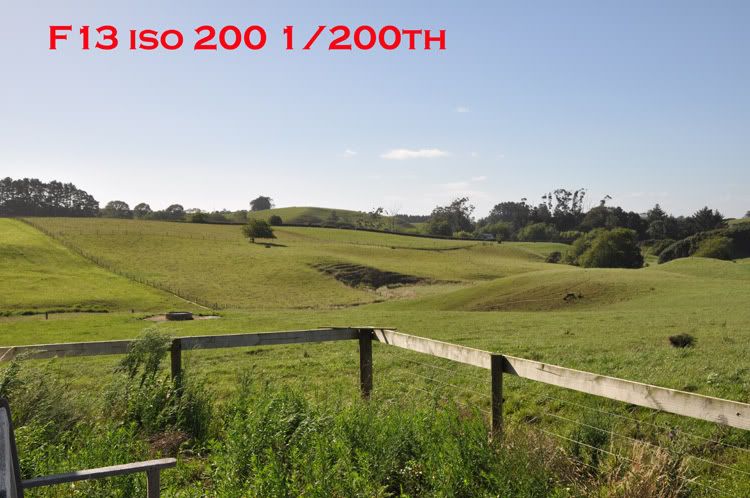
To give him the benefit of the doubt I stood 6 feet away , he mentioned 8-10 feet .
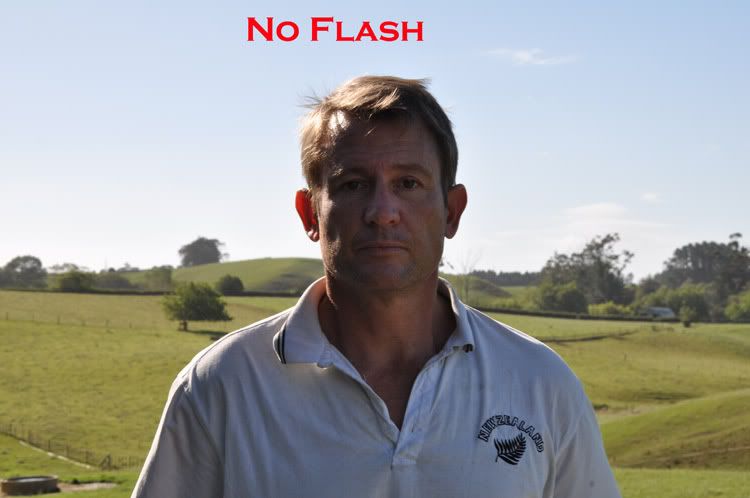
Just to make sure we were getting the full potential of the flash I set the flash to manual and full power ....
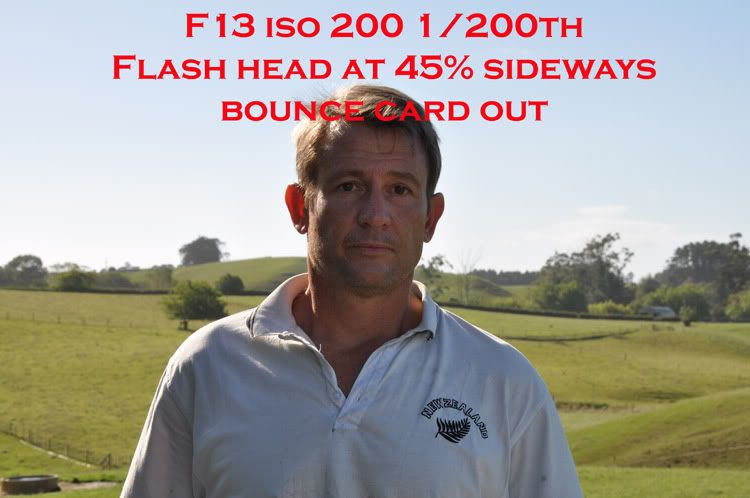
Pretty dismal isn't it [ not the subject! ]
Then I went to TTL/BL -1 direct flash ...

I won't show the picture of my face 2 feet from the camera but when I put the camera in manual at those settings at 1/128th power it tells me I have 0.6m working distance .... with direct flash that is .
At 0.6m [ 2 feet ] with the flash in the suggested position there is still not enough flash at full power .... this suggests that we are getting less than 1/128th of the power from the sideways light using the suggested setup .
You will use more than 150 X the flash power and flatten your batteries more than 150 X faster using this ' technique ' .
I rest my case ... it's a bad suggestion regardless of who made it .
When I buy a camera I expect everything on it to work .
I expect everything in the manual to be correct .
And when I pay for a book of photography knowledge I expect it to be correct .
If anyone has anything to add to this page please let me know !
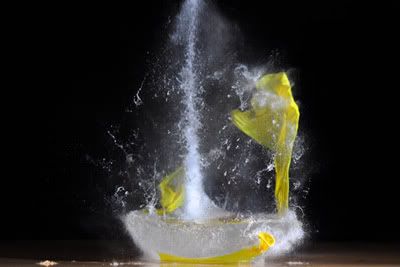
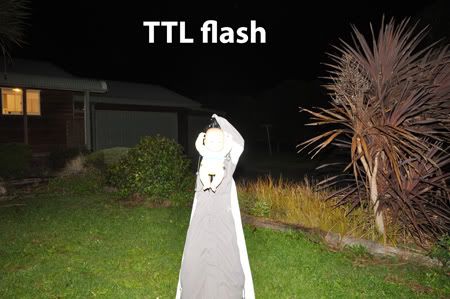
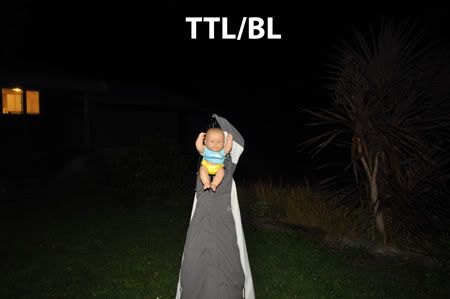




Did you take the background shot in manual mode, and keep it there for the remaining shots (changing only the flash). Could you have stopped down one f-stop and darkened the background without changing the exposure on your face in TTL-BL
ReplyDeleteAll shot in manual mode - one setting - for ambient exposure [ I should have put the settings up - I'll do that when I get home from holiday ].
ReplyDeleteYes I could have darkened the background more , in the brigtest sunlight possible I would have about 5 metres working distance with direct flash . If I darkened the background with a smaller aperture TTL/BL would compensate accordingly for the same exposure on the subject .
The fill-card method works well, particularly with non-ttl flash. I would, of course, keep the flash pointed forward and UP at 45 deg. when outside with nothing to bounce off of. Since the 70s I have used a 3x5 card kept on the strobe with a rubber band. a little fill=1/4" of card, more fill=1/2" of card showing, etc..
ReplyDeleteMany people use fill outdoors like that - but turning the flash head sideways makes very little sense .
ReplyDeleteDesmond,
ReplyDeleteIs this advice (yours I mean) still applicable when you have the camera in A or S mode? I am slowly going through your teachings but I think it might take me longer to break the A or S usage habit.
rgs,
Matt
Yep , applicable in all modes . :)
ReplyDelete